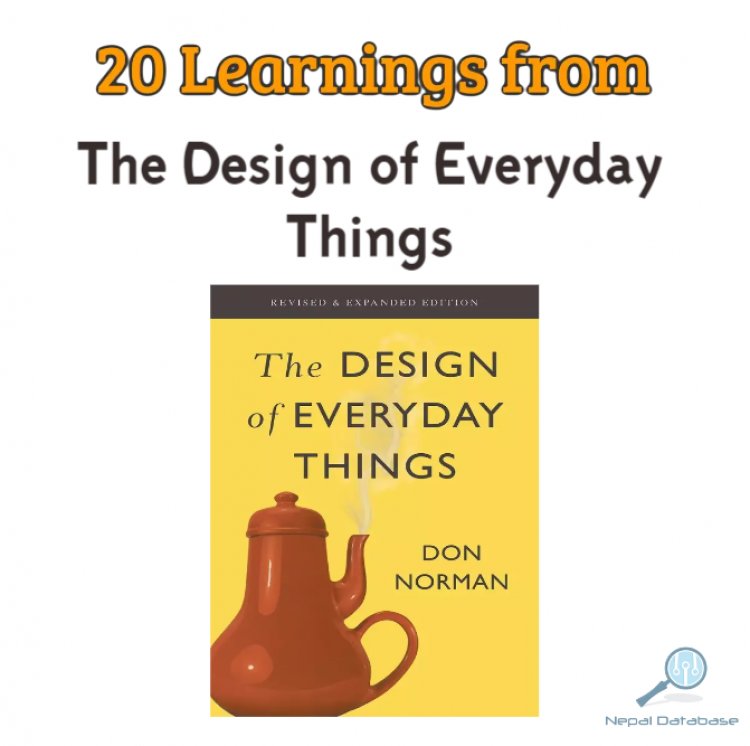20 Key Takeaways from "The Design of Everyday Things" by Don Norman
Discover the fundamental principles of good design with these 20 important learnings from Don Norman's classic book 'The Design of Everyday Things.' Learn about user-centered design, human perception, error psychology, and more.

"The Design of Everyday Things" is a classic book written by Don Norman and published in 1988. The book explores the concept of design and how it affects our daily lives. Norman argues that good design is not just about aesthetics or functionality but it should be focused on the user and their experiences. He discusses the role of human perception and cognition in design and highlights the importance of considering the design of everyday objects, such as doors, light switches, and telephones. Here are 20 important learnings from this book:
-
User-centered design is essential
Norman stresses the importance of considering the user's needs and perspectives when designing products. This means designing with the user in mind, rather than simply focusing on aesthetics or functionality. -
Human perception and cognition play a role
Norman discusses the role of human perception and cognition in design. He explains that users' experiences of products are influenced by their perceptions, memories, and expectations, and that designers must take these into account when creating products. -
The psychology of error is important
Norman explores the reasons behind user errors and the impact that poor design can have on user experience. He argues that designers must design systems that are forgiving, meaning they are easy to recover from errors, and that they provide clear feedback to users when something goes wrong. -
Design of everyday objects must be considered
Norman provides numerous examples of everyday objects, such as doors, light switches, and telephones, and analyzes the design of each in terms of usability, accessibility, and user experience. He highlights the importance of considering the design of everyday objects and how they can impact the user experience. -
Universal design is necessary
Norman advocates for universal design, which means designing products that are usable by the widest possible range of users, including those with disabilities. -
Good design should provide clear feedback
Norman emphasizes the importance of providing clear feedback to users. This includes feedback on the status of a system, feedback on the consequences of user actions, and feedback on how to correct errors. -
Design should be simple and natural
Norman argues that good design should be simple and natural, meaning that users should not have to think about or learn how to use a product. -
Constraints can improve design
Norman suggests that constraints, such as limiting the number of options available to users, can actually improve the design of a product by making it easier for users to make decisions. -
Affordances are important
Norman introduces the concept of affordances, which are the physical and perceptual properties of an object that suggest how it should be used. He argues that designers must make the benefits of their products clear and obvious to users. -
Mapping is crucial
Norman explains the importance of mapping, which is the relationship between the controls of a product and their effects. He argues that the mapping should be consistent, direct, and appropriate, meaning that the relationship between controls and effects should be easy to understand. -
Consistency is key
Norman highlights the importance of consistency in design. This means that the same actions should have the same effects regardless of the context in which they are performed. -
Design should provide a conceptual model
Norman argues that good design should provide a conceptual model, which is a mental model of how a product works. This model should be clear, consistent, and easy to understand. -
Error messages should be informative
Norman discusses the importance of error messages, explaining that they should be informative, giving users the information they need to correct the problem. -
Good design is about relationships
Norman argues that good design is about relationships, meaning the relationships between objects, the relationships between users and objects, and the relationships between users and the environment. -
Design should enhance meaning
Norman explains that good design should enhance meaning, meaning that the design should help users understand the purpose and meaning of an object or system. -
Design should provide a good fit
Norman argues that good design should provide a good fit, meaning that the design should be appropriate for the context in which it is used and the users who will use it. This includes taking into account the physical, social, and cultural context in which a product will be used. -
Design should be aesthetically pleasing
Norman suggests that good design should be aesthetically pleasing, meaning that it should look good and be visually appealing to users. However, he also notes that aesthetics should not come at the expense of usability or accessibility. -
The design of systems is important
Norman highlights the importance of designing systems, meaning the collection of objects, processes, and interactions that make up a product or service. He argues that designers must consider the design of systems as a whole, not just individual components. -
Emotional design is critical
Norman introduces the concept of "emotional design", which means designing products that evoke emotional responses from users. He argues that emotional design can improve the user experience and increase user engagement with a product. -
Design must be evaluated
Norman stresses the importance of evaluating design, both in terms of usability and effectiveness. He suggests that designers must continually evaluate and improve their designs, taking into account user feedback and the changing needs of users over time.
In "The Design of Everyday Things," Don Norman provides a comprehensive guide to the principles and practices of good design. He stresses the importance of considering the user and their experiences when designing products, and highlights the critical role that design plays in shaping our daily lives. The book provides valuable insights for designers and non-designers alike, and is considered a seminal work in the field of design. Whether you're an experienced designer or just starting to explore the world of design, "The Design of Everyday Things" is an essential read that will deepen your understanding of design and its impact on the world around us.
What's Your Reaction?





































































































